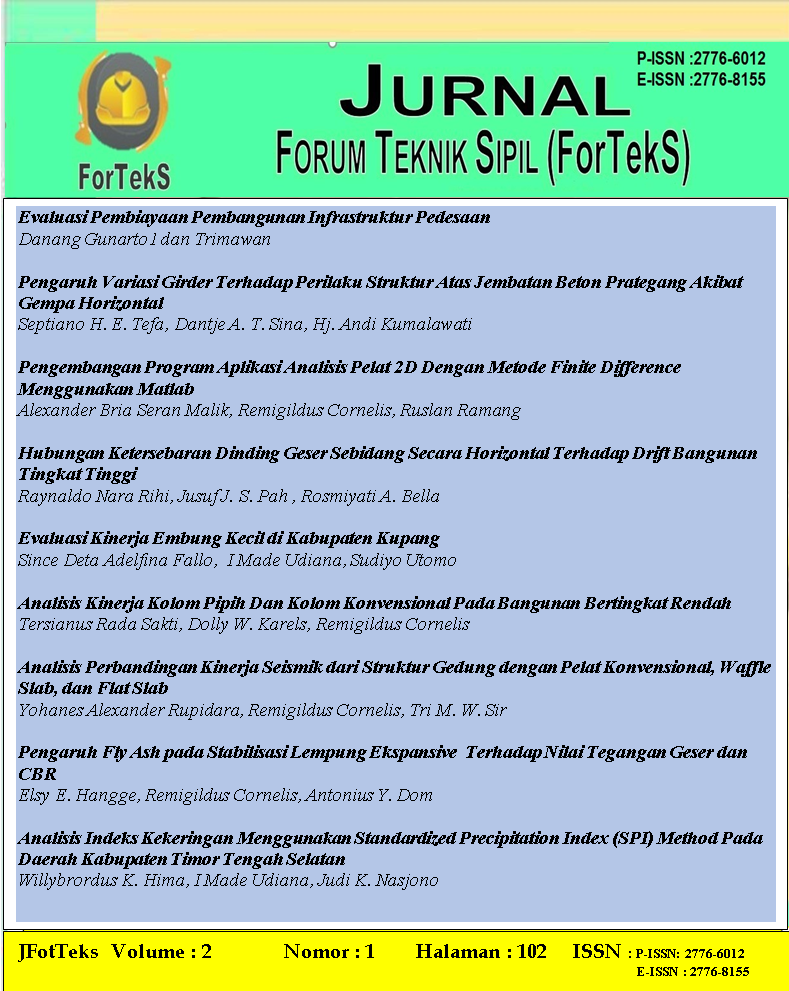Analisis Indeks Kekeringan Menggunakan Standardized Precipitation Index (SPI) Method pada Daerah Kabupaten Timor Tengah Selatan
Drought Index Analysis Using Standardized Precipitation Index (SPI) Method In The Regency Of Timor Tengah Selatan
Abstract
Due to the low rainfall, it is relatively uneven in each sub-district in Timor Tengah Selatan (TTS) Regency. It causes some rivers to be drought-prone in the dry season. This study aims to determine the largest drought index and map the drought distribution in the South Central Timor (TTS) Regency. The drought index analysis uses the Standardized Precipitation Index (SPI) Method. The data used is monthly rainfall data for ten years (2009-2018) of ten rain stations. Then, mapping of drought distribution rainfall using ArcGIS Software. The results of the drought index analysis showed that in the 1-month deficit period, the largest drought index was -3.61, which occurred in March 2014 at the Oeekam Rain Station. In the 3-month deficit period, the largest drought index was -3.19, which occurred in March 2010 at the Nulle Rain Station and in November 2015 at the Kesetnana Rain Station. The findings of the drought distribution map study suggest that during the 1-month shortfall period, all sub-districts experienced drought in January, February, and April. Meanwhile, in the 3-month deficit period, drought occurs evenly for all sub-districts only in June.
Downloads
References
Aziz, Abdul, and Ali Masduqi. 2013. “Indeks Kekeringan Di Kabupaten Nganjuk.” Jurusan Teknik Lingkungan, Institut Teknologi Sepuluh November.
Febyana Dwy Triesna, Kadek. 2016. “Analisis Tingkat Kekeringan Di Wilayah Lombok Bagian Selatan Dengan Menggunakan Metode EDI (Effective Drought Index).” Jurusan Teknik Sipil, Universitas Mataram.
Hayes, Michael J, Mark D Svoboda, Donald A Wiihite, and Olga v Vanyarkho. 1999. “Monitoring the 1996 Drought Using the Standardized Precipitation Index.” Bulletin of the American meteorological society 80(3): 429–38.
Ina-Geoportal. 2021. “Peta SHP Kabupaten Timor Tengah Selatan.” https://tanahair.indonesia.go.id (Februari 1, 2021).
Jocom, Hary, Daniel D Kameo, Intiyas Utami, and A Ign Kristijanto. 2016. “Air Dan Konflik: Studi Kasus Kabupaten Timor Tengah Selatan.” Jurnal Ilmu Lingkungan 14(1): 51–61.
Noviana, Ana. 2015. “Kekeringan: 10 Sumur Bor Di Timor Tengah NTT.” Bisnis.com. https://kabar24.bisnis.com/read/20150626/78/447683/kekeringan-10-sumur-bor-di-timor-tengah-ntt (June 24, 2021).
Novitasari, Nyoman Winda, Arief Laila Nugraha, and Andri Suprayogi. 2015. “Pemetaan Multi Hazards Berbasis Sistem Informasi Geografis Di Kabupaten Demak Jawa Tengah.” Jurnal Geodesi Undip 4(4): 181–90.
Reed, Shelia. 1995. “Pengantar Tentang Bahaya.” Program Pelatihan Manajemen Bencana. UNDP.
Saidah, Humairo, M Bagus Budianto, and Lilik Hanifah. 2017. “Analisa Indeks Dan Sebaran Kekeringan Menggunakan Metode Standardized Precipitation Index (SPI) Dan Geographical Information System (GIS) Untuk Pulau Lombok.” Jurnal Spektran 5(2): 173–79.
Sila, Candri. 2016. “Analisa Kekeringan Di Kecamatan Sekotong Dengan Metode Standardized Precipitation Index (SPI) Dan Desil.” Jurusan Teknik Sipil, Universitas Mataram.
Jurnal ForTeks memberikan akses terbuka terhadap siapapun agar informasi dan temuan pada artikel tersebut bermanfaat bagi semua orang. Semua artikel jurnal ini dapat diakses dan diunduh secara gratis, tanpa dipungut biaya sesuai dengan lincense creative comons yang digunakan
ForTeks : Jurnal Forum Komunikasi Teknik Sipil is licensed under a Creative Commons Attribution-ShareAlike 4.0 International License

 Willybrordus Kurniawan Hima(1)
Willybrordus Kurniawan Hima(1)

















